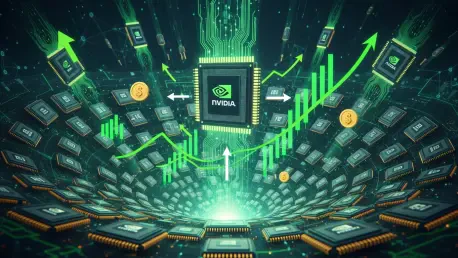In a stunning display of market dominance, Nvidia has reported fiscal third-quarter earnings that not only exceeded Wall Street’s forecasts but also highlighted the insatiable global appetite for artificial intelligence technology, marking a transformative era in the tech industry. With revenue soaring to $57.01 billion against an expected $54.92 billion, and adjusted earnings per share reaching $1.30 compared to the anticipated $1.25, the company has cemented its position as a titan in the tech industry. This remarkable performance, driven by unprecedented demand for AI chips, signals a transformative era where Nvidia’s innovations are fueling advancements across multiple sectors. Beyond the numbers, a projected fourth-quarter sales figure of $65 billion—surpassing analyst expectations of $61.66 billion—further underscores the robust confidence in the company’s future, as evidenced by a more than 4% surge in stock price during extended trading. This sets the stage for a deeper exploration of how Nvidia is shaping the AI landscape and navigating a dynamic global market.
Dominance in the AI Sector
Unmatched Growth in Data Center Sales
Nvidia’s ascent to becoming the most valuable publicly traded company is largely attributed to its pivotal role in the AI revolution, particularly through its graphics processing units (GPUs) that power complex AI models. The company’s data center sales, a cornerstone of its revenue stream, reached an impressive $51.2 billion in the recent quarter, surpassing analyst predictions of $49.09 billion and marking a 66% increase from the previous year. A significant portion of this—$43 billion—stemmed from GPU sales for computing, bolstered by the early rollout of the GB300 chips. Additionally, networking components that allow multiple GPUs to operate seamlessly as a unified system contributed $8.2 billion to the segment. This surge reflects the critical reliance of tech giants like Microsoft, Amazon, and Google on Nvidia’s technology to build and scale their AI infrastructure, positioning the company as an indispensable player in the industry.
Innovation with Blackwell Ultra Chips
Further solidifying Nvidia’s leadership, the Blackwell Ultra, the second-generation iteration of its Blackwell chip family, has emerged as the best-selling chip series in its portfolio. This rapid adoption of cutting-edge technology, as noted by finance chief Colette Kress, highlights the company’s ability to stay ahead of market needs with innovative solutions. The demand for such advanced chips is driven by the urgent requirement for faster, more efficient processing power to handle increasingly sophisticated AI applications. Major cloud providers, often referred to as hyperscalers, have placed orders worth a staggering $500 billion for the coming years through 2026 and 2027, indicating a sold-out status for cloud GPUs. This overwhelming order backlog, coupled with Kress’s optimism about further growth in order volumes, paints a picture of a market that shows no signs of slowing down, with Nvidia at the forefront of this technological wave.
Broader Industry Trends and Challenges
AI Infrastructure Investment Boom
The broader tech industry is experiencing a seismic shift with massive investments in AI infrastructure, and Nvidia’s performance serves as a key indicator of this ongoing boom. CEO Jensen Huang has firmly dismissed concerns about an AI bubble, emphasizing the robust and sustained demand for the company’s products. This confidence is mirrored by actions from Nvidia’s major clients—Microsoft, Meta, Amazon, and Alphabet—who have collectively raised their capital expenditure forecasts to over $380 billion this year to support AI development. Such aggressive spending underscores a shared belief in the transformative potential of AI and the critical role of Nvidia’s technology in realizing these ambitions. Huang’s reassurance about market stability, backed by tangible financial commitments from industry leaders, suggests that the AI surge is a long-term trend rather than a fleeting phenomenon.
Diversified Portfolio and Regional Hurdles
While Nvidia excels in AI, its strength across other business segments showcases a well-rounded portfolio that mitigates over-reliance on a single revenue source. Gaming revenue, a historical pillar for the company, climbed 30% year-over-year to $4.3 billion, driven by sustained demand for chips in 3D video gaming. The professional visualization segment, featuring innovations like the DGX Spark AI desktop computer, reported $760 million in sales, up 56% from last year. Robotics and automotive sales also saw a 32% annual increase to $592 million, marking another growth frontier. However, challenges loom in specific markets like China, where geopolitical tensions and fierce competition have curtailed sales of the ##0 chip to a mere $50 million despite export licenses. Finance chief Colette Kress expressed disappointment over the lack of significant purchase orders in the region, highlighting how external pressures can impact even a powerhouse like Nvidia.
Financial Strength and Shareholder Commitment
Nvidia’s financial health remains a testament to its operational success and strategic foresight, with net income skyrocketing 65% to $31.91 billion, or $1.30 per share, compared to $19.31 billion the previous year. This profitability, amid rapid expansion, reflects efficient management and a strong market position. The company also demonstrated a commitment to shareholder value by repurchasing $12.5 billion in shares and paying out $243 million in dividends during the quarter. Such actions not only reward investors but also signal confidence in sustained growth. While regional challenges persist, the overwhelming positive indicators—from record-breaking earnings to a diversified business model—suggest that Nvidia navigated the complexities of the global market with remarkable agility, setting a high benchmark for the tech industry as it looked to future opportunities.
Reflecting on a Transformative Quarter
Looking back, Nvidia’s third-quarter achievements painted a vivid picture of a company at the pinnacle of the AI revolution, with revenue and earnings that redefined industry standards through its data center dominance. The robust growth across gaming, visualization, and robotics segments complemented this narrative, showcasing a balanced approach to innovation. Despite facing headwinds in markets like China due to geopolitical constraints, the overall trajectory remained upward, driven by a massive order pipeline and unwavering investor trust. As the tech landscape continues to evolve, stakeholders should closely monitor how Nvidia leverages its position to address regional challenges while capitalizing on the escalating demand for AI infrastructure. Exploring partnerships and alternative markets could mitigate risks, ensuring that the momentum built in this transformative period carries forward into future quarters with even greater impact.









